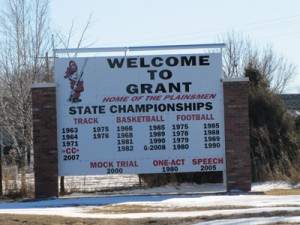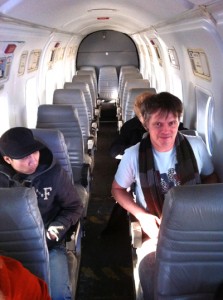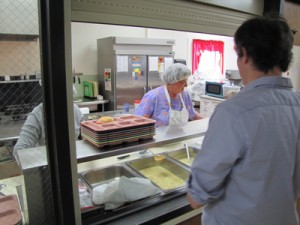“I want to send our scientists to rural schools and communities around the U.S. to talk about evolution for Darwin Day 2011.” Jory Weintraub’s words hung undigested in the silent air of the management meeting at our North Carolina center last July.
“You want to send our scientists where?” I jested. “On purpose?”
In my two years overseeing the daily operations of the science group at the National Evolutionary Synthesis Center, or NESCent, I have come to expect inventive programs from Weintraub, my counterpart in our education and outreach group. Core to our mission is innovation, a challenge we were tasked with by the National Science Foundation when they created the center to promote the synthesis of information and concepts on outstanding questions in evolutionary science.
Craig McClain speaks to students in the Perkins High School gym in Grant, Neb. (Craig McClain)

This time, however, his idea caught me somewhat off guard. And yet, a half year later, I found myself in rural Nebraska alongside Gregor Yanega, a NESCent biologist who works on hummingbird evolution. The temperature is 10 degrees Fahrenheit, and we, Team Nebraska, were not quite sure what to expect.
On our way to Nebraska, Yanega and I bumped into a scientific colleague at Chicago’s O’Hare Airport. When we spoke of our Darwin Day activities, he responded with similar bemusement, a cocked eyebrow, and a variation of my original question to Weintraub. From scientific colleagues to my family in rural Arkansas, the general response fell between incredulity and curiosity.
This is because all of us know that despite no shortage of evidence of evolution in the world around us, the concept remains controversial. Just under half of Americans believe the theory of evolution is not supported by any confirmed facts. A recent poll found that 42 percent of the public also believes the theory of evolution conflicts with their religious views. A new study also suggests that many public high school biology teachers may be overly cautious in advocating for evolutionary biology in the classroom. Their caution arises because they do not feel they understand it well enough to teach it properly, or they are trying to avoid a controversial topic, or in some cases because they do not “believe” in evolution themselves.

A church along on highway 61 near Grant, Neb. (Craig McClain)
The discord goes beyond just evolution and extends to science as a whole. Even some political movements are now setting anti-science agendas. So perhaps unsurprisingly, Darwin Day celebrations often only occur at universities, museums, science centers and other safe havens. In rural American primary schools, and even urban schools, the concept of the Darwin Day Road Show, as we came to call our program, was unprecedented. Dramatic as it sounds, it was, and is, an experiment with risks for the superintendents, principals and teachers who invited us into their schools and for the scientists who ventured into the unknown.
Despite these reasons explaining why a cautious evolutionary biologist would not want to venture into the heartland of America when called upon, NESCent scientists overwhelmingly volunteered to participate and share their research. Being from a rural Arkansas town, I jumped at the opportunity to participate and convey my passion about science and evolutionary biology to an audience often not exposed to it. Honestly, how often does a marine biologist from a landlocked Southern state have the chance to visit Western Nebraska and talk about the thing he loves?
Other NESCent scientists brought additional motivations. Jenny McGuire, who examines the evolution of fossil mammals, visited a Virginia county school just 15 miles from her own hometown. “I saw it as a fun homecoming, a chance to inform the public about science and how to be good scientific citizens.” Another member of Team Virginia, Jennifer Verdolin, who studies the evolution of communication and sociality in prairie dogs, volunteered because it was “outside of the bounds of what we typically do for science outreach.”
A third team — John Logsdon, a biology professor at the University of Iowa and former NESCent sabbatical fellow with expertise on the evolution of sex, and Julie Meachen, a NESCent fellow examining the evolution of large carnivores like the saber-tooth cat — represented Team Iowa.
We received nearly two dozen invitations from educators within small schools and communities. We selected participants who would not otherwise have access to Darwin Day activities and would allow us the opportunity to speak candidly with students and public alike. Ultimately, the teachers of each participating school held the key to the project’s success: They laid the groundwork and ensured these exchanges were instructive and positive events.
NESCent worked hard in advance to ensure the success of our visits. In January, all the Road Show teams participated in a workshop and role-playing led by Josh Rosenau of the National Center for Science Education to prepare for the questions we might field during our visits. While we may excel in our respective areas of evolutionary biology, many of us had never immersed ourselves in the culture wars that surround the field. In breakout groups, we wrote our hopes and fears for the experiment.
The city of Grant, Neb., where one of the Darwin Day presentations took place. (Craig McClain)

Our hopes? We wanted to convey the excitement and relevance of science, that scientists are part of the general public (you may even see us shopping at the grocery store) and to begin building a community of support for science. Our fears? We worried about being patronizing, being able to communicate effectively, not having answers and becoming caught up in contentious interactions. I later realized this training was only necessary to relieve our own apprehension.
As Gregor Yanega and I drove past a sign listing state championships of the Perkins County High School Plainsmen in Nebraska and into the small town of Grant, population around a thousand, I begin to feel anxious. Despite the phone calls and assurances, I still wondered how we would be received.
Perkins County High School proceeded cautiously as well, with emails and phone calls between NESCent and school officials instilling confidence on both sides. The principal wanted assurances that we were not pursuing any atheist — or any religious — agenda. We assured him that we did not want to broach these subjects any more than they wanted us to. Once we conveyed to teachers and administrators that our only goals were to discuss our research and talk about careers in science, much of the problems dissolved. We only wanted to excite others about the science that excites us.
The day before we rolled into Grant, Yanega and I visited the University of Nebraska at Kearney, where we met with undergraduates and lectured to both university and public audiences. We were met with enthusiasm and warmth, but admittedly, a university town, even in rural Nebraska, is far from foreign soil. The next morning at Perkins County High, we were welcomed by Scott King, our host teacher and by the combined smell of floor wax, wood and cafeteria food that characterizes any American school. Moments later, and center court, Yanega and I were talking about evolution in squids and birds in the high school gym.
As the day unfolded, Yanega and I were overwhelmed with the graciousness, enthusiasm and sincerity of the teachers, school administration and particularly the students that hosted us.
Gregor Yanega, in the blue shirt, on the flight from Colorado to Nebraska. (Craig McClain)

Over the course of our visits, the questions we received from students were thoughtful and founded in sheer curiosity about the science we presented. Indeed, the questions were the most exciting part of our collective visits. After I spoke about why giant squid are giant and the evolution of body size, a student asked, “Who would win between a giant squid and Chuck Norris?” Answer: “It depends on whether they were fighting on land or water.”
In response to Jenny McGuire’s talk about the rise of mammals, a student asked, “Why didn’t dinosaurs make a comeback?” McGuire was asked a variant of this question, “Why didn’t mammals also go extinct when dinosaurs did?” a few days later by a prominent university dean of sciences. Our visits served to remind us all that children, and even adults, are naturally and enthusiastically curious about the world around them.
Ours was not the only warm reception; other Road Show teams at Dan River Senior High School in Virginia and Muscatine High School in Iowa experienced the same. Indeed, at times we felt like rock stars! It is a rare and gratifying day in the life of any scientist when sixth-graders in Montana want your autograph. An Iowa student commented on a blog: “I really appreciated them taking time out of their day and week to come to our high school especially when we aren’t a well-known or famous school.” I often asked myself the reverse question when I entered a school. “Why would this school open its doors to me?”
When I asked all the Road Show scientists if they would participate again next year, without hesitation I received responses of “yes,” “definitely” and “absolutely.” Why? Because for all of us the Darwin Day Road Show was a gratifying adventure that no one will forget. From the landscapes with their silos, combines, center pivot crop circles, high school gymnasiums, to the indelible interactions we had along the way, we absorbed it all.
Joshua Hanna, our teacher from Iowa, emailed us: “I just wanted to share with you how amazing the whole experience was. It was INCREDIBLE! The event was well attended and the students had a blast picking John [Logsdon] and Julie [Meachen’s] brains.”
Jory Weintraub’s bigger picture was to send teams out to share our enthusiasm for evolutionary science, introduce people to the diverse types of research we do and open students’ minds to the possibilities of careers in science. All of us found our interactions on these topics engaging, rewarding and important. “I actually wish I would have more interactions with students,” Jenny McGuire said after returning from Virginia.
Gregor Yanega partakes of some of the high school cuisine. (Craig McClain)

NESCent’s goal was not only to talk about evolutionary biology on Darwin’s birthday but also to offer an alternative to stereotypes of science and scientists in general. As Jennifer Verdolin stated, “We may be the only people they know doing anything like this.” Near the end of our visit to Perkins County High School, a 10th-grader told us, “You guys are not what I expected from scientists. You’re more normal.” After Verdolin’s talk on barking in prairie dogs to inform other prairie dogs about food location, a student in good fun began to yell “Cake, Cake!” to alert other students about the cutting of the birthday cake for Darwin.
Although I returned from my 5,600-mile, two-state whistle-stop tour physically and mentally bushed, I also returned to North Carolina invigorated.
Were there glitches? Yes, but none so large as to overshadow the positives of this experiment.
Take my wild-card experience. Four days in, I proceeded on to Montana near the Canadian border arriving near midnight sans luggage. The superintendent of this school had dealt with both local and national attention the previous semester when a student faced expulsion after accidentally bringing a rifle (used the previous weekend for hunting) to school in her car trunk. Understandably, the superintendent originally shied away from the potential of creating more disruption. It was just two weeks before my arrival that the host teacher convinced the principal to allow me to speak with her sixth-grade classes. Ultimately, the administration and teacher should be commended for allowing this. Indeed, while administrative officials and teachers proceeded cautiously, their foresight and willingness to engage with NESCent fostered the spirit of communication and dialogue.
Will there be a Darwin Day Road Show 2012?
“There is already talk of planning something for Darwin Day next year, and I think this would have been unlikely without the Road Show visit this year,” said Dawn Simon, our host at the University of Nebraska at Kearney. “I don’t think it is an exaggeration to say that for some students, it may have been a life-altering experience.”
Gregor Yanega prepares for his lecture at the University of Nebraska Kearney. The room only has one audience member when this was taken, but 15 minutes later, it was packed. (Craig McClain)

Scott King emailed me from Nebraska a few days after my and Yanega’s visit, “Almost every day since you were here, I have heard students, parents and teachers talking about the presentation. Everyone has had good things to say, and I have yet to hear anything negative about the entire event. It was a major hit with my students, and they have asked if you will be coming back next year. I even had a student approach me yesterday asking me details about marine biology as a future career opportunity.”
So yes, with these invitations and our combined triumphs, there will be a Darwin Day Road Show 2012. In fact, NESCent plans for all 50 states by 2015.
Some criticize the Darwin Day Road Show for being nothing more than a “Darwinist ministry,” others for it not being more explicit in its discussion of evolution and Darwin. I consider this a win. It means we have found a middle ground that allows scientists to stop communicating at and start communicating with the public. In the words of my colleague Kevin Zelnio, “If people are not part of the conversation, they are not invested in the discussion.”
As I waited to depart Nebraska for Montana, I had hours to kill. I found myself in an outdoor sporting goods store searching for warmer socks. The young woman at the check-out asked if I am the “Giant Squid Guy” from the lecture two nights ago. My “yes” launched us into a dialogue that affirmed for me that our engagement, however brief, left a positive impression, one that could last a lifetime. Perhaps through the Darwin Day Road Show, we have gained some new participants in the conversation and inspired some future colleagues. And perhaps, it reminds us all that interactions between science and society need not be contentious. At its heart, science is about questions, and we all naturally ask them.



